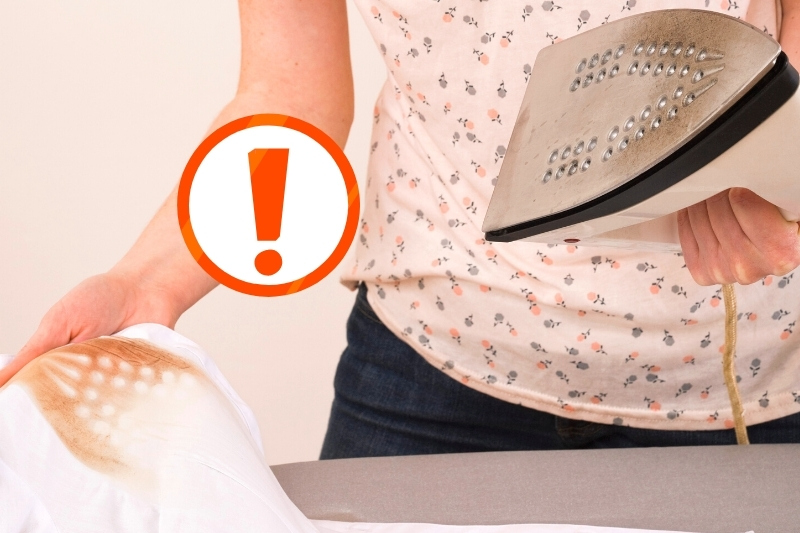Iron marks and stains can be tricky to remove, and they often leave unsightly and obvious stains on clothes!
So, whether you left an iron flat on your top and went to answer the door, or you chose the wrong setting to iron your trousers on, you need to know how to eradicate the ugly scorches from your outfit!
Below you’ll find a guide on how to remove iron marks from your clothes. It is, however, worth keeping in mind that not all scorches can be treated and removed.
In some cases, the damage is too bad and if you were to treat the damaged item you could make the problem worse.
If this happens you should either ask a professional cleaner for further advice or perhaps you could upcycle your item of clothing.
What Causes Iron Marks on Clothes?
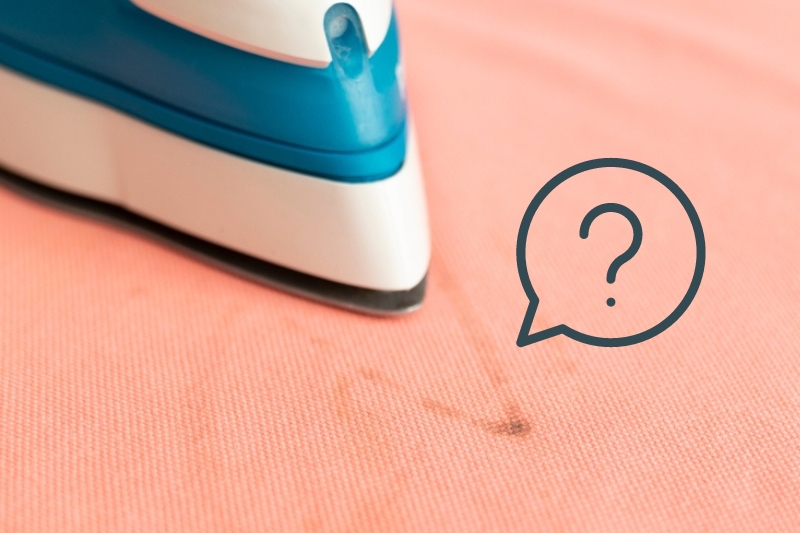
There are multiple reasons why your clothes have iron marks on them, these include:
- Your iron is too hot and is, therefore, scorching the material you’re attempting to iron.
- You’ve held your iron in one place for too long.
- You’ve used the wrong setting and not adhered to the advice on the garment’s care label.
- You’ve ironed over a transfer (graphic/logo), and you’ve transferred the colours onto the rest of your outfit. In the process, you’ve started leaving colourful iron shaped prints over the item.
Important Tips for Removing Iron Marks from Clothes

Check out the tips below before you remove iron stains from your outfits:
- Act fast! The sooner you address the iron marks the better your chances are of removing the blemishes from your outfit. Delaying this treatment and leaving the iron mark to age only makes it harder to remove.
- Always read the care tag on your garment before you treat it. On the care tag you’ll find information about caring for your item. It’s crucial that you stick to the advice given on the label, otherwise you run the risk of damaging your outfit.
- Test your chosen treatment out before you use it to treat your iron marks. Pop some product on a discreet seam, wait a few minutes, and then check the material to see if there’ve been any adverse effects. If you don’t see any issues (damage/discolouration) you can continue to use the product to treat the iron marks.
- If in doubt, ask a dry cleaner for help! They should even be able to treat and rectify the problem for you.
- Take your time when trying to remove iron marks as they’re not the easiest blemishes to remove from clothes!
- Be prepared to repeat some of the methods below more than once. And in some cases, you might have to try multiple methods below to remove an iron mark.
- As soon as you notice an iron mark on an item, remove the iron from the material, pop it to one side, and turn it off.
How to Get Iron Marks Out of Clothes
Below you’ll find out how to remove iron marks from clothes. But as mentioned earlier, how well these treatments work out depends on a number of factors, including how bad the mark is, what material it’s on, and how quickly you’ve reacted to it.
It’s likely that you’ll have to repeat some of the methods mentioned below more than once. And in some cases, you might have to use more than one of the methods to treat the iron marks on your outfits.
Method 1: Liquid laundry detergent

Steps to follow:
- Stop ironing immediately.
- Rinse the damaged item under lukewarm water.
- Massage a dose of liquid laundry detergent into the stained area.
- Wait a few minutes for the detergent to penetrate the material’s fibres.
- Pop the item inside the washing machine.
- Choose an appropriate washing cycle (as per the instructions on the care label).
- Add a dose of detergent.
- Start the wash.
- Inspect the item when the cycle ends. If there are still iron marks on the item of clothing, repeat this treatment or try another method on this list.
- Only dry the item when you know the iron marks have gone. It is also better to dry the item of clothing outside on a line, so the sun can ‘naturally bleach’ any remaining marks.
Method 2: White vinegar and bicarbonate of soda

Steps to follow:
- In a bowl mix equal parts of white vinegar and bicarbonate of soda to make a paste. Mmake enough paste to cover the entire stain.
- Spread the paste over the whole stain.
- Gently massage the paste into the iron mark using your fingers.
- Wait half an hour (although if the stain is old or troubling you can increase this time to an hour).
- Rinse the paste off the item using cold water.
- Pop the item inside the washing machine, choose an appropriate washing cycle, and add a dose of detergent.
- Start the cycle.
- Check the item when the cycle ends. If there are still iron marks on the item of clothing, repeat this treatment or try another method on this list. Do not dry the item until the stain has gone.
Note: If you don’t fancy using white vinegar and bicarbonate of soda at the same time, you can use the products separately. You can, instead, soak iron-stained laundry in a bucket of diluted white vinegar, or you can create a bicarbonate of soda and water paste and spread this over the iron stain.
Method 3: Lemon juice and salt
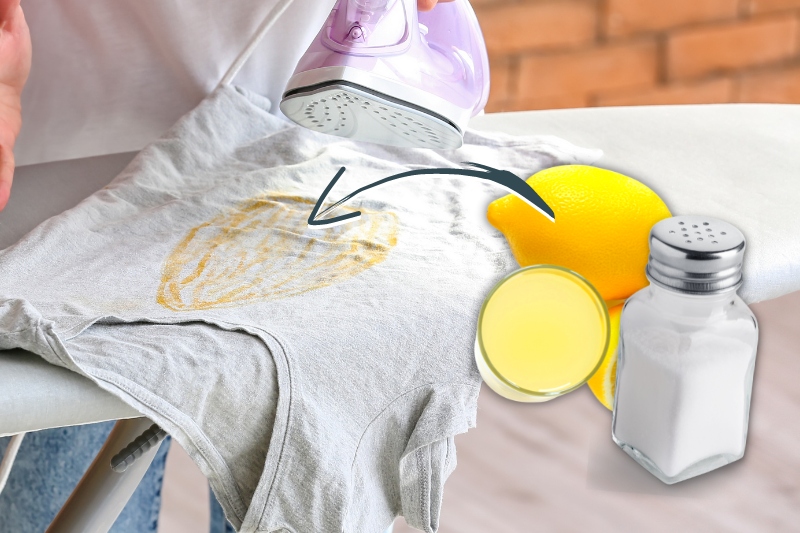
Steps to follow:
- Mix equal parts of lemon juice and salt in a bowl.
- Spread the paste you’ve created over the whole iron stain.
- Massage the paste into the iron mark using your fingers.
- Wait half an hour (for old or troubling iron marks you can increase this time to one hour).
- Rinse the paste off the item using cold water.
- Launder the item in the washing machine – choose an appropriate washing cycle and add a dose of detergent.
- Start the cycle.
- Inspect the item when the cycle ends. And if there are still iron marks on the item of clothing, repeat this treatment or try another method on this list. Do not dry the item until the stain has gone.
Note: Lemon juice can sometimes have a ‘bleaching’ effect on clothes, so it would be better to use this method on white coloured clothes.
Method 4: Hydrogen peroxide
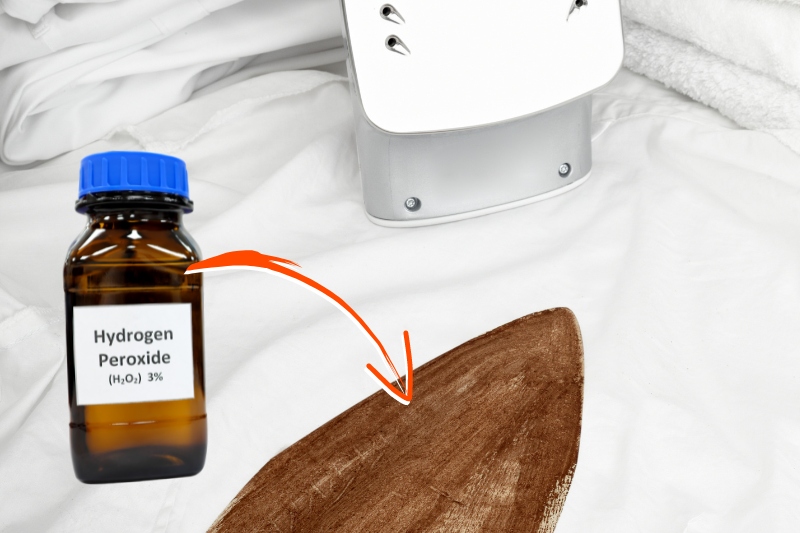
Tip: Make sure you do a patch test first!
Steps to follow:
- Fill a shallow bowl up with a small amount of hydrogen peroxide.
- Dip a cotton bud into the liquid.
- Start blotting at the stained area with the damp cotton bud.
- Make sure you cover the whole stained section in hydrogen peroxide – remember to re-soak the cotton bud in the hydrogen peroxide frequently throughout this process.
- Wait a minute or two at most.
- Rinse the item under the cold water tap and then inspect it. Repeat the steps above if need be.
- Wash your item as normal.
Note: Hydrogen peroxide will discolour colourful clothes, so only use it on white clothes. And as this is a strong chemical, you should not use it on delicate materials.
Method 5: Bleach
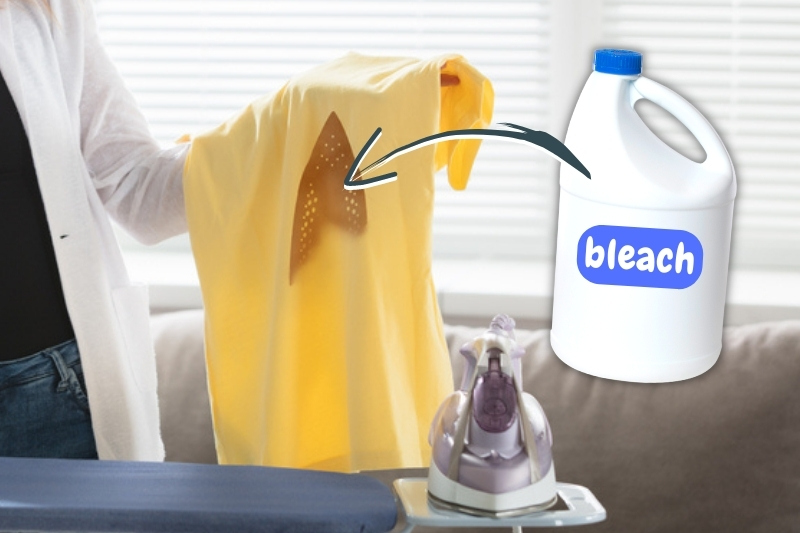
If you’ve got iron marks on white clothes or colourfast clothes, you can bleach them with oxygen bleach/non-chlorine bleach (triangular symbol with two horizontal lines on the clothing’s care label).
Simply add a dose of bleach to water and soak your clothes in the liquid for a set period of time – read the packaging on the bleach bottle you decide to buy to find out what measurements to use.
If you have iron marks on white coloured clothes, you can use chlorine bleach to treat them (an empty triangular symbol on the clothing’s care label). Just dilute a measure of bleach in water and pop the garments in the liquid to soak.
You cannot bleach non-colourfast clothes. Similarly, if you read the care label on your outfit and it says ‘do not bleach’ or you see a solid triangle with a cross going through it, the item must not be bleached.
If you were to bleach these types of clothes you’d likely discolour them, and/or you may cause irreparable damage to the material.
Method 6: Dry cleaning

For extremely stubborn iron marks, stains on delicate or priceless pieces of clothing, or if you’ve not had much luck with the methods above, you should ask a dry cleaner for help.
Dry cleaners generally have access to tools and products that you wouldn’t normally have at home. So, they can use these items to treat the iron stains on your clothes.
A quick online search will bring up dry cleaners near you – just remember to pick a reputable company, and find someone who has a lot of experience in dealing with this problem!
How to Avoid Getting Iron Marks on Clothes

Iron marks are not the easiest kind of stains to remove, so it’s better to prevent any potential damage from occurring in the first place. Find out how you can avoid getting iron stains on your clothes below:
-
- Always read the care label on the outfit you want to iron before you iron it. The label will tell you how to care for your garment correctly.
- Stick to the advice on the care label, failing to do so could result in you scorching the material.
- Double-check that you’ve chosen the correct temperature on your iron before you start ironing.
- Remember to change the settings on your iron before you move on to ironing a new garment. Every item you iron will come with its own care instructions that you need to adhere to.
- Invest in an ironing board to help with the ironing.
- Turn clothes inside out and iron them. This is particularly useful if you need to iron clothes that have transfers on them.
- Try not to iron over zips, buttons and transfers.
- Continuously move your iron around as you iron. Never hold the iron in one place for too long.
- Pop an ironing cloth over your item of clothing and then iron over the cloth. The cloth will act as a barrier between the iron’s soleplate and the material. In turn, the hot iron will not make direct contact with the fabric, so the item of clothing will be protected from the heat. This is an essential step to take when ironing delicate materials, like silk.
- If you’ve ironed over a transfer/general dirt, remember to clean the iron’s soleplate before you continue to iron your outfit. If you forget to clean the soleplate, you run the risk of transferring the grime onto your garment as you iron it, this in turn, could stain the material.
Are Iron Stains Permanent?
Iron stains can become permanent if they are left untreated for prolonged periods of time, if the stains are particularly troubling, or if they are on a particular type of material. In extreme cases, iron marks can cause irreparable damage to clothes.
However, if you react quickly to the stain and treat it at speed, you should be able to remove a lot of the stain and reduce its appearance significantly.
You can treat an iron stain with a natural remedy or you can buy an official stain remover from a shop – both options tend to work out well.
If you’re handling a delicate material, a vintage piece or an heirloom, for example, it would be better to take the item in question to a dry cleaning store to get their help with removing the iron blemish. They have access to different equipment, so they should be able to remove/reduce the stain without causing more damage to the garment.
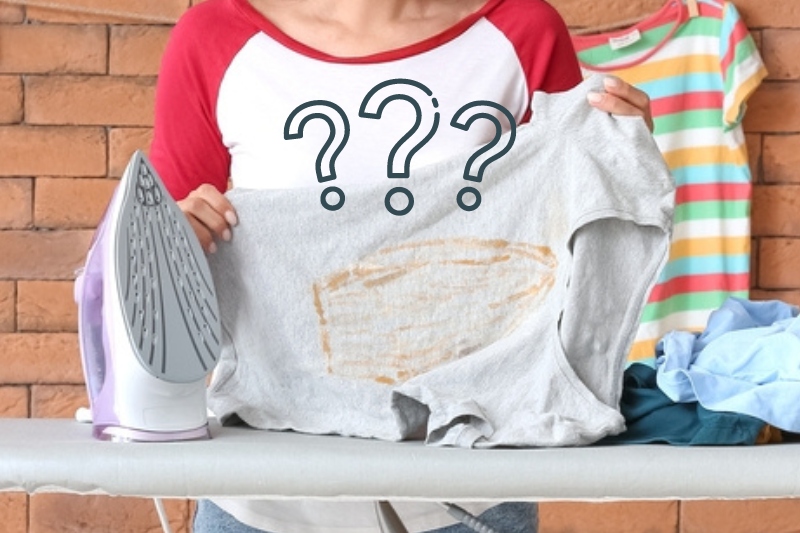
How Do You Remove Old Iron Stains?
Old iron stains are quite tricky to remove. And depending on the extent of the damage, some iron marks cannot be eradicated from items of clothing.
Here are some tips to help you remove your aged iron stains as best as you can:
- You can try any of the treatments listed above, but you may have to repeat them multiple times.
- Invest in an off-the-shelf stain remover and apply it to the stained area(s) as per the instructions on the packaging.
- If you have a coloured or white item of clothing that has been tarnished with iron marks, you can bleach it as long as it is colourfast or white. Do not bleach clothes that are not colourfast as the bleach will discolour and damage them! Just dilute a dose of oxygen bleach in water and soak the garment (use chlorine bleach on white clothes only!)
- Ask a dry cleaner for help. A dry cleaner has access to different tools and products, so they should be able to help you out with your iron-stained item.
It’s worth keeping in mind that prevention is often better in this kind of situation.
So, always read the care tag on your item of clothing, set your iron to the right temperature, practise a good ironing technique, and continuously move your iron around, so you don’t scorch the fabric.
And if you do happen to damage your item of clothing with an iron, act as fast as you can and remove the stain quickly—don’t allow the stain to age!
A fresh stain is often easier to remove, and if you react in good time, you should be able to take out the majority of the stain.
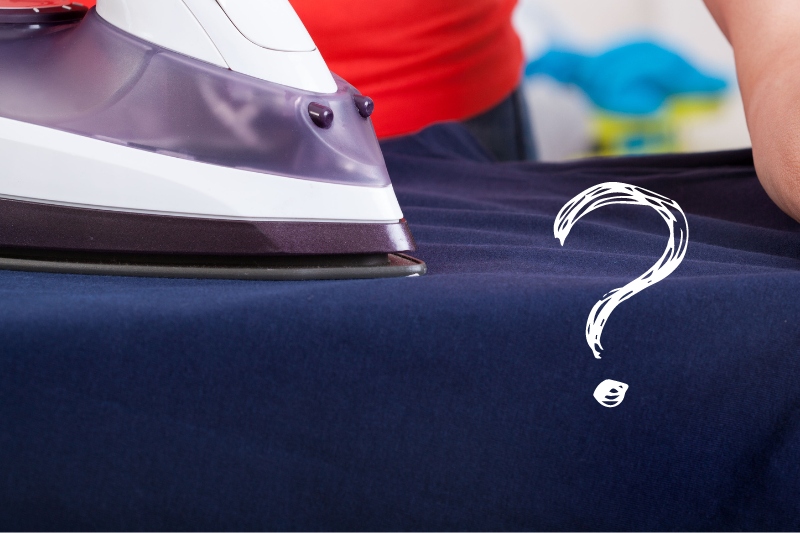
Why Do My Clothes Have Shiny Marks on them After Ironing?
Clothes can have shiny marks on them after they’ve been ironed for a few different reasons.
The most common cause is that the iron is too hot, and the heat from the iron has caused some damage to the material, hence the shiny blemish.
Here are a the most common reasons:
- The heat from the iron can damage the fibres of some material. This can leave a glazed look on the surface of the item you’re ironing. This is quite a common occurrence with polyester and nylon items because they’ve got a lower melting point, hence the fibres melt and start to look shiny.
- The pressure you apply when ironing can make outfits a tad shiny. By pressing too hard on the material you’re ironing, you almost force the fibres flat and this can sometimes result in a glowing mark being left behind on the fabric.
- Certain fabrics are more prone to shiny marks too. For example, delicate materials like silk are often more prone to getting a glowing effect after being ironed.
- The way you iron can cause shiny blemishes on clothes. For example, if you iron too quickly you might damage the material during this process, and this can affect the material’s fibres.
Shiny marks don’t really enhance an outfit’s appearance, and the glowing blemishes are often difficult to remove from clothes.
This is why it’s always better to try and stop the pesky marks from making an appearance in the first place.
So, before you iron an item, check its care label, select the right temperature and setting on the iron, and use an ironing cloth to minimise shiny-related damages.

Bethan has a passion for exploring, reading, cooking and gardening! When she’s not creating culinary delights for her family, she’s concocting potions to keep her house clean!
